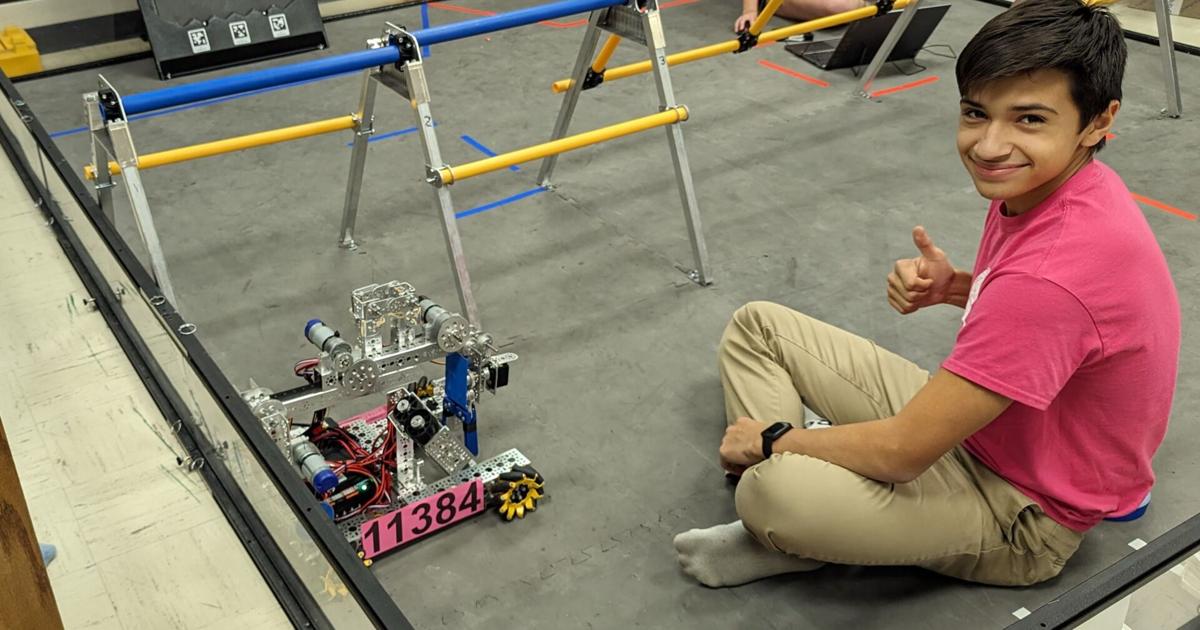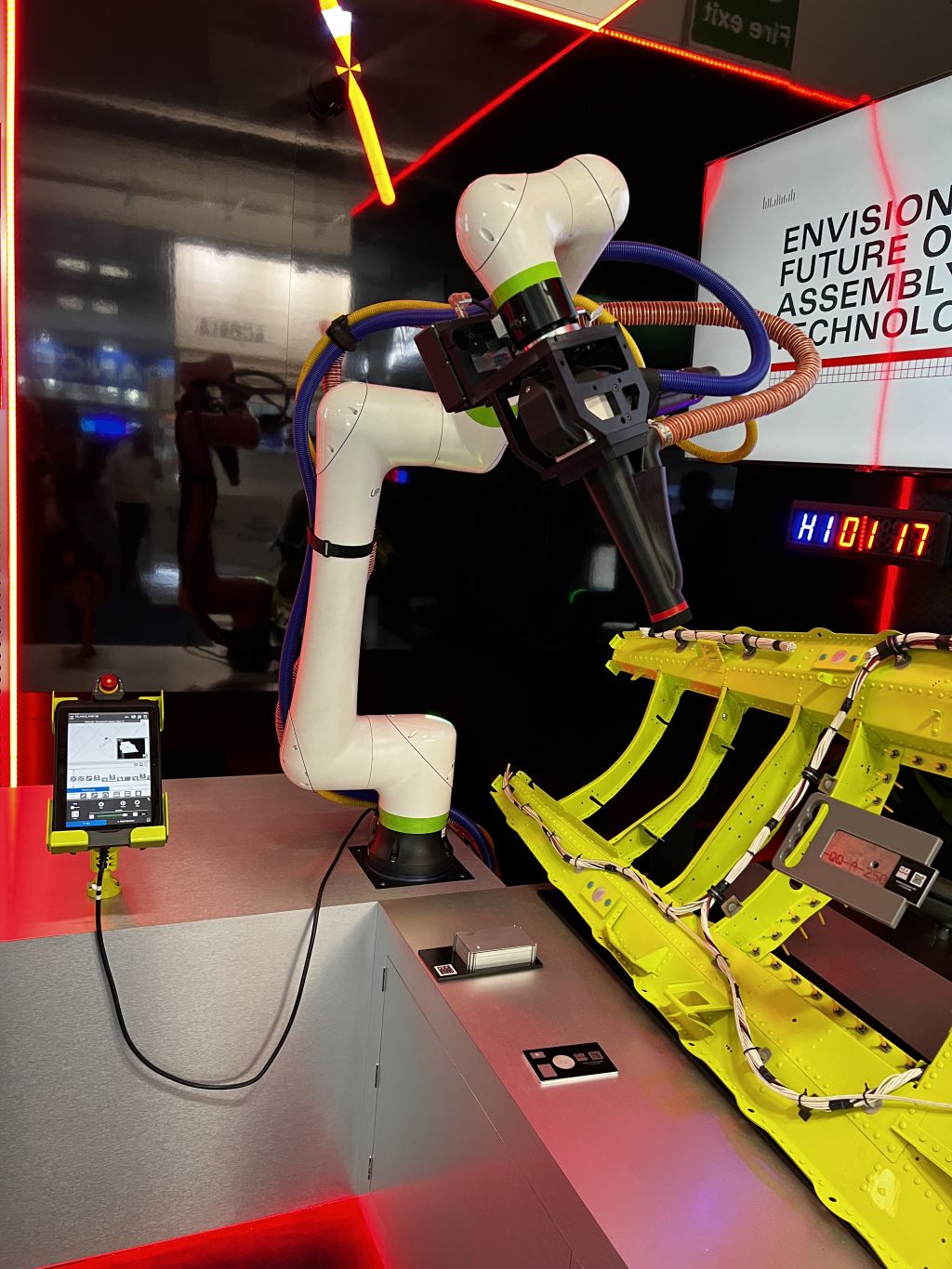Dr. Myriam Curet has been instrumental to Intuitive’s success in recent years. [Photo courtesy of Intuitive Surgical]
Intuitive Surgical has pioneered robotic surgery since the 1990s, continuously driving innovation and collaboration through data to advance patient care.
Teamwork between surgeons and engineers has been a crucial factor behind Intuitive developing effective surgical platforms that solve real-world problems that surgeons face.
Multibillion-dollar companies including Medtronic and Johnson & Johnson — and smaller up-and-comers including CMR Surgical and Vicarious Surgical — have sought to take on Intuitive in the soft-tissue surgical robotics space in recent years, but Intuitive remains the dominant company. An important element of Intuitive’s continued success has been its ability to harness data, collaborate with surgeons, and innovate.
As a practicing surgeon who actively uses robotic surgery technology, Intuitive Chief Medical Officer Dr. Myriam Curet understands the importance of the company’s partnership with surgeons more than most.
“I can obviously work with the engineers directly and work with them about what kind of innovations we need, how to make things better and give some feedback. That’s a large part of what I’ve done. There are many surgeons who do that. There’s nothing unique about me as a CMO,” Curet told Medical Design & Outsourcing. “We get input from many surgeons of all levels — academics, novice surgeons, community experience, GYN, many different kinds of specialties— because that’s important. We serve a broad customer base.”
She and other surgeons provide immediate feedback to engineers with data on how specific technologies work, what innovations are needed and how to improve things.
Such cooperation drove the development of the da Vinci Xi surgical robot, which launched in the 2010s. In fact, the da Vinci Xi robot addressed most of the issues surgeons and care teams complained about in previous models, including the need for better ergonomics and longer instrument reach, said Curet, who joined Intuitive in 2005 and became CMO in 2014.
This level of collaboration — where surgeons identify the needs and engineers develop the solutions — appears to be key if Intuitive is to continue to dominate robotic surgery though exciting innovations.
“Intuitive took such a lead for many years that they’ve done a very good job of increasing the moat around the system by enhancing the value, and that has made the stickiness of the system greater. As a result, it’s hard for competitors to come in,” BTIG analyst Ryan Zimmerman told MDO.
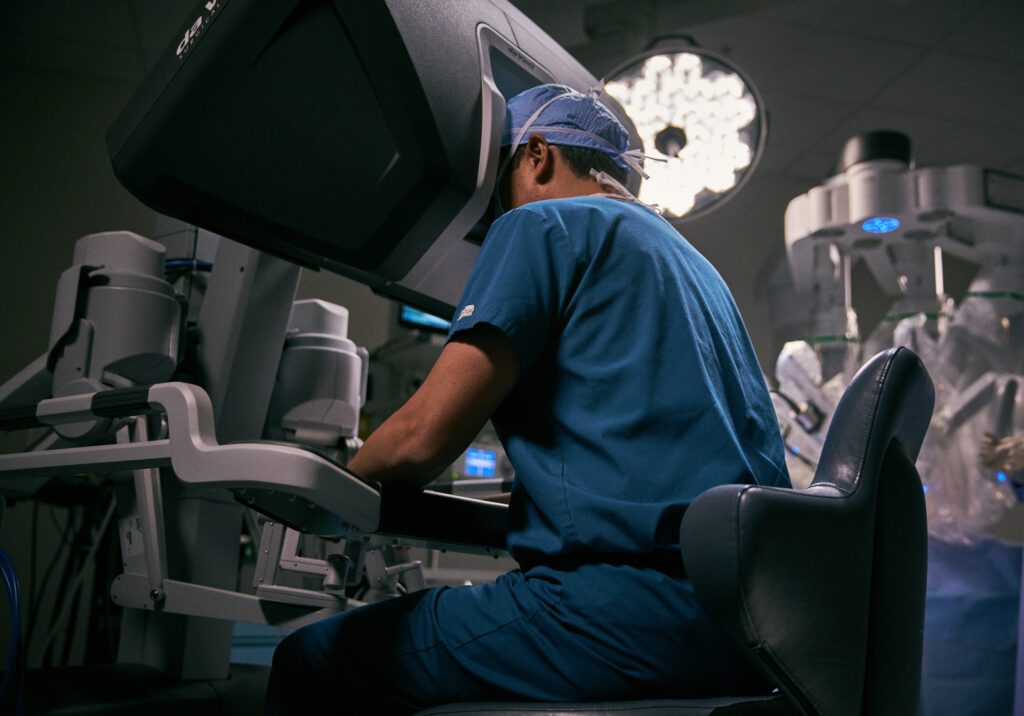
A surgeon uses the da Vinci surgeon console during a procedure. [Photo courtesy of Intuitive Surgical]
Committing to clinical validation and evidence-based practice
With the trial and error of surgical systems comes rigorous clinical validation and evidence-based practice. Intuitive Surgical does studies on its surgical systems, the surgeons that use the systems do studies, and there is literature published that Intuitive Surgical considers in the clinical validation process.
Zimmerman has watched the process evolve, as an analyst and previously as a director of surgery inside health providers.
“For a while, the pathway to approval was not clear. There was uncertainty. There were discussions for many years about whether companies need clinical trials,” Zimmerman said. ” I think, for that reason, that has informed developments in this space.”
Intuitive’s pre-market validation process involves extensive testing by engineers to compare new products to existing technologies and ensure they can fully and safely perform intended functions. Post-market validation includes analyzing real-world clinical outcomes data, reviewing complaints and adverse events and monitoring published literature to identify where risks were effectively mitigated and areas still needing improvement. Intuitive also conducts clinical studies in post-market.
Curet said both validation processes aim to gather information on patient outcomes and how products function to determine what needs improvement or adaptation with new products and technologies. Patient safety is a top priority throughout the development and ongoing use of Intuitive Surgical’s technology, Curet said.
“What safety systems can we put in place? What training systems can we put in place? What can we do? And then we follow that up with watching it being used in real life to see where they effectively mitigated where some risks we had and identified,” she said.
Because of these data systems in the validation process, patient outcomes and industry standards were positively impacted in a few key ways.
It has helped demonstrate robotic surgery’s clinical value and benefits over traditional open or laparoscopic approaches in areas like reduced recovery time, pain and complications. Gathering extensive real-world use data has allowed Intuitive to continuously improve its technologies and address any risks, helping lead to better patient safety outcomes. Publishing clinical studies and data has established evidence that robotic surgery provides benefits, raising industry standards of practice. This clinical validation is essential for regulatory approval and adoption.
“There are now so many robots out there with various form factors that I would argue companies will not be able to make it to market without clinical validation,” Zimmerman said.
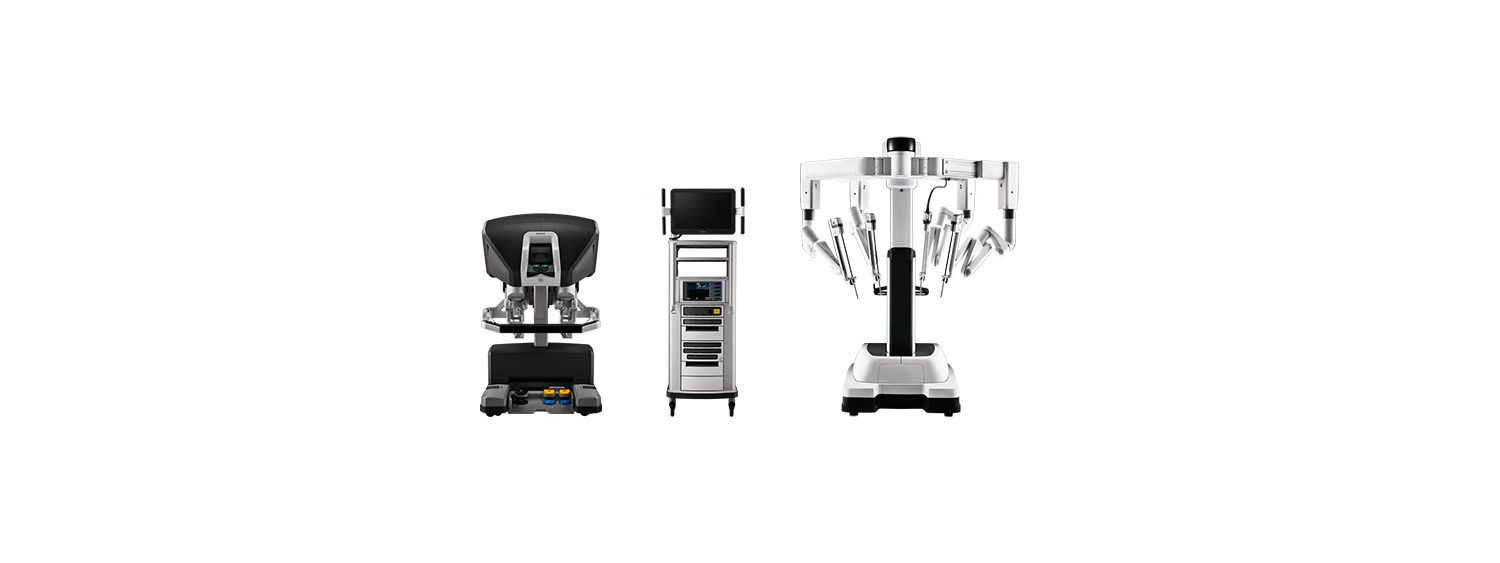
The da Vinci surgical ecosystem, including patient cart, surgeon console and vision tower. [Photo courtesy of Intuitive Surgical]
Surgeon-engineer collaboration is essential for robust validation data
Intuitive Surgical’s clinical validation process is based on collaborative relationships between surgeons and engineers.
The company gathers extensive feedback from thousands of surgeons on how they use current systems and what improvements could be made to develop the next generation of surgical robotics. Engineers also regularly observe surgical procedures using Intuitive’s systems in the operating room to understand real-world usage of the technology.
Curet said the best example of this collaboration is Intuitive Surgical’s shift from its Si surgical robot to the da Vinci Xi.
“That was years and thousands of surgeons coming in and trying things. That was hundreds of engineers going into the OR and seeing how our current system, or Si at that point, was being utilized and tens of thousands of interviews with people,” she said. “We follow that process.”
As a result of the feedback, da Vinci Xi was built to be boom-mounted with slimmer arms and longer-reaching instruments. Intuitive also added integrated tabled motion to dynamically position patients while the surgeon operates.
“It was so clear when Xi came out that it was about solving every problem that surgeons and care team members had complained about,” Curet said. “Everything that was limiting for surgeons and care teams in [da Vinci] Si got addressed in Xi.”
The influence of data on surgeon adoption
Data and insights from using the da Vinci robot have helped influence the adoption of robotic surgery in the operating room. Some surgeons need hands-on experience while, others want increasingly strong evidence from published data, showing the need for multiple types and data sources to drive adoption among different groups.
For early adopters, personal experience using the robot and seeing its capabilities firsthand was enough to convince them of its benefits over other approaches.
“There was a surgeon many years ago who said he used the da Vinci for a ventral hernia, where you put mesh in, and he used the tackers that he normally uses laparoscopically on one side. He used suturing with the da Vinci on the other side, and the next day, the patient was complaining of a lot of pain on the side where they use the tackers, and no pain on the side where they use the da Vinci,” Curet said.
Publications from initial clinical experiences and case studies demonstrated potential value in outcomes like reduced recovery times. This influenced the early majority surgeons. More extensive database studies and randomized controlled trials providing data on improved outcomes across patient populations addressed concerns of the late majority surgeons who wanted more robust evidence before adopting. Ongoing collection of real-world use data helps demonstrate the persistent value of robotic surgery and builds the case for its benefits compared to traditional methods.
For use data, the My Intuitive app captures surgical data on each procedure a surgeon performs using the da Vinci system. It tracks details like how long the surgeon was on the system, which instruments they used, how long each step took and how long each instrument was utilized. This data is then provided back to the surgeon so they can track improvements in their OR time, compare their instrument usage to others and identify higher-performing surgeons to learn from. The app aims to provide individualized and comparative performance data to help drive surgeon improvement.
“Intuitive has done a very good job of providing physicians and hospital administrators alike with information and analytics about their surgical programs. Just as a golfer would study their golf swing with video, so can a surgeon study their surgeries,” Zimmerman said. ”That’s something we’ve been exploring for years in hospital management — making sure that our robotic programs are effective but also financially sound. And Intuitive is embracing that.”
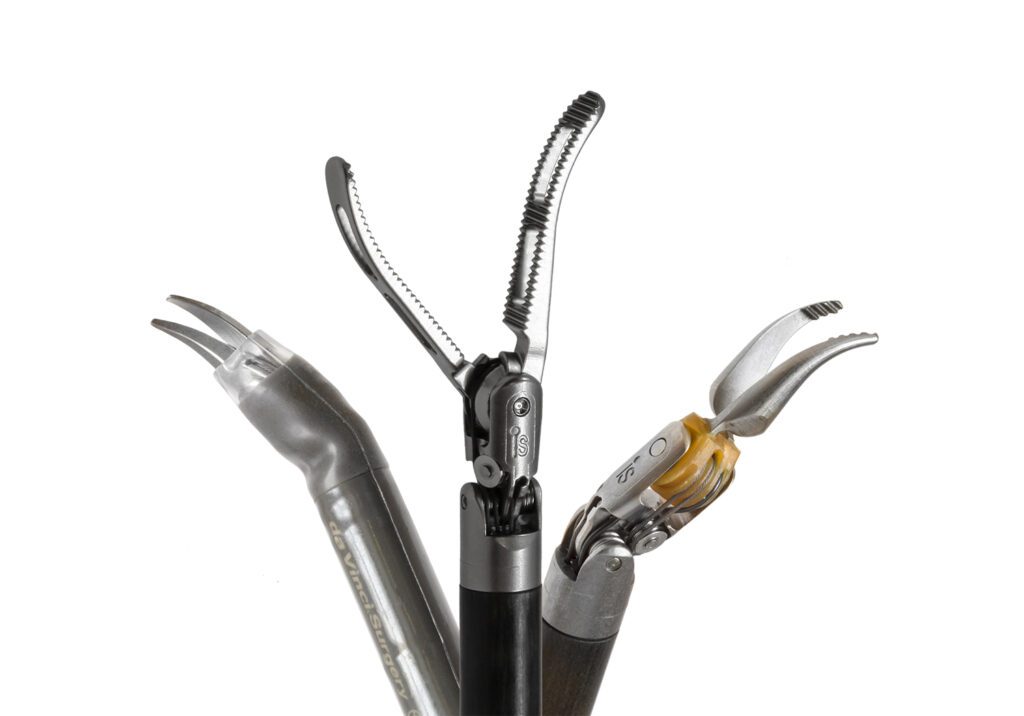
Surgical instruments on the da Vinci Xi surgical robot [Photo courtesy of Intuitive Surgical]
Where is surgical robotics headed?
Analysts think there will be more widespread adoption of surgical robotics, as long as the platforms have a more universal approach. There’s also a potential to combine therapeutic care and diagnostics in the same episodic care.
“Robotics is going to be increasingly more universal in that you can’t have ten disparate systems inside of hospitals that treat ten disparate indications. Hospitals can’t afford that. And I think you’ll see more expansion of existing systems in the new applications,” Zimmerman said.
Intuitive Surgical is working on moving toward that pathway. Curet said that the future of surgical robotics will have a focus more on leveraging technology and data.
“Most of our competitors’ platforms are not radically different from ours,” Curet said. “So if you look at that type of platform, we’re going to be able to penetrate more into benign surgery in the U.S., we’re going to penetrate more into cancer surgery outside the U.S.”
Another prospect in surgical robotics is more flexible robotics, such as Intuitive’s Ion robotic bronchoscopy system with an ultrathin, maneuverable catheter that lets surgeons reach small lesions deep in the lungs. It enables minimally invasive biopsies that could become crucial to early diagnosis.
Curet also sees advances in imaging capabilities to help surgeons view things like cancer cells and nerves that are not currently visible.
“What I think is really exciting is that with robotics, the biggest difference is you’ve put a computer between the patient and whoever the care provider is. And that expands your ability in terms of what you can do, what information you can give the provider that he or she didn’t have before,” she said.
Intuitive Surgical is exploring fluorescence imaging to look at cells that surgeons cannot see with the naked eye. Some of that includes structures like the ureter, which is at risk of getting cut during surgery. If surgeons can see using an imaging agent, it can decrease complications. Cancer cell imaging are also an area of interest for the company.
The company is looking at its single port platform for nipple-sparing mastectomy procedures to reduce pain and other associated complications. There’s also potential to use the surgical robotic platform to go inside the prostate to do a prostatectomy for patients with benign prostatic hypertrophy.
However, surgical robotics in general have a lot of growth opportunities and potential in the future as more companies enter the space, according to Zimmerman.
“There is increasingly more competition,” Zimmerman said. “There’s a lot of opportunities, but we haven’t quite figured out how essentially to democratize it so that it’s accessible for everyone.”









